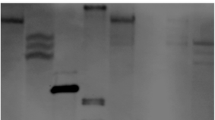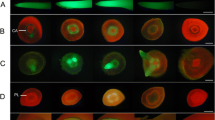Abstract
Native promoters that can drive high and stable transgene expression are important tools for modifying plant traits. Although several such promoters have been reported in soybean (Glycine max), few of them function at multiple growth and development stages and during nodule development. Here, we report that the promoters of 40S RIBOSOMAL PROTEIN SMALL SUBUNIT S28 (RPS28) and EUKARYOTIC TRANSLATION INITIATION FACTOR 1 (EIF1) are ideal for high expression of transgene. Through bioinformatic analysis, we determined that RPS28 and EIF1 were highly expressed during soybean growth and development, nodule development, and various biotic and abiotic stresses. Fusion of both RPS28 and EIF1 promoters, with or without their first intron, with the reporter gene β-GLUCURONIDASE (uidA) in transgenic soybean, resulted in high GUS activity in seedlings, seeds, and nodules. Fluorimetric GUS assays showed that the RPS28 promoter and the EIF1 promoter yielded high expression, comparable to the soybean Ubiquitin (GmUbi) promoter. RPS28 and EIF1 promoters were also highly expressed in Arabidopsis thaliana and Nicotiana benthamiana. Our results indicate the potential of RPS28 and EIF1 promoters to facilitate future genetic engineering and breeding to improve the quality and yield of soybean, as well as in a wide variety of other plant species.




Similar content being viewed by others
Data availability
The datasets generated during and/or analysed during the current study are available from the corresponding author on reasonable request.
References
Bansal R, Mittapelly P, Cassone BJ, Mamidala P, Redinbaugh MG, Michel A (2015) Recommended reference genes for quantitative PCR analysis in soybean have variable stabilities during diverse biotic stresses. PLoS ONE 10(8):e0134890
Chai C, Lin Y, Shen D, Wu Y, Li H, Dou D (2013) Identification and functional characterization of the soybean GmaPPO12 promoter conferring Phytophthora sojae induced expression. PLoS ONE 8(6):e67670
Chen H, Adam Arsovski A, Yu K, Wang A (2017) Deep sequencing leads to the identification of eukaryotic translation initiation factor 5A as a key element in Rsv1-mediated lethal systemic hypersensitive response to Soybean mosaic virus infection in soybean. Mol Plant Pathol 18(3):391–404
Chen L, Jiang B, Wu C, Sun S, Hou W, Han T (2014) GmPRP2 promoter drives root-preferential expression in transgenic Arabidopsis and soybean hairy roots. BMC Plant Biol 14:245
Chiera JM, Bouchard RA, Dorsey SL, Park E, Buenrostro-Nava MT, Ling PP, Finer JJ (2007) Isolation of two highly active soybean (Glycine max (L.) Merr.) promoters and their characterization using a new automated image collection and analysis system. Plant Cell Rep 26(9):1501–1509
Clough SJ, Bent AF (1998) Floral dip: a simplified method for Agrobacterium-mediated transformation of Arabidopsis thaliana. Plant J 16(6):735–743
Dynan WS, Tjian R (1985) Control of eukaryotic messenger RNA synthesis by sequence-specific DNA-binding proteins. Nature 316(6031):774–778
Feng ZJ, Liu N, Zhang GW, Niu FG, Xu SC, Gong YM (2019) Investigation of the AQP family in soybean and the promoter activity of TIP2;6 in heat stress and hormone responses. Int J Mol Sci 20(2):262
Freitas EO, Melo BP, Lourenço-Tessutti IT, Arraes FBM, Amorim RM, Lisei-de-Sá ME, Costa JA, Leite AGB, Faheem M, Ferreira MA et al (2019) Identification and characterization of the GmRD26 soybean promoter in response to abiotic stresses: potential tool for biotechnological application. BMC Biotechnol 19(1):79
Goodstein DM, Shu S, Howson R, Neupane R, Hayes RD, Fazo J, Mitros T, Dirks W, Hellsten U, Putnam N et al (2012) Phytozome: a comparative platform for green plant genomics. Nucleic Acids Res 40:D1178-1186
Govindarajulu M, Elmore JM, Fester T, Taylor CG (2008) Evaluation of constitutive viral promoters in transgenic soybean roots and nodules. Mol Plant Microbe Interact 21(8):1027–1035
Grant TN, De La Torre CM, Zhang N, Finer JJ (2017) Synthetic introns help identify sequences in the 5’ UTR intron of the Glycine max polyubiquitin (Gmubi) promoter that give increased promoter activity. Planta 245(4):849–860
Higo K, Ugawa Y, Iwamoto M, Korenaga T (1999) Plant cis-acting regulatory DNA elements (PLACE) database: 1999. Nucleic Acids Res 27(1):297–300
Knight H, Veale EL, Warren GJ, Knight MR (1999) The sfr6 mutation in Arabidopsis suppresses low-temperature induction of genes dependent on the CRT/DRE sequence motif. Plant Cell 11(5):875–886
Koellhoffer JP, Xing A, Moon BP, Li Z (2015) Tissue-specific expression of a soybean hypersensitive-induced response (HIR) protein gene promoter. Plant Mol Biol 87(3):261–271
Le Hir H, Nott A, Moore MJ (2003) How introns influence and enhance eukaryotic gene expression. Trends Biochem Sci 28(4):215–220
Lescot M, Déhais P, Thijs G, Marchal K, Moreau Y, Van de Peer Y, Rouzé P, Rombauts S (2002) PlantCARE, a database of plant cis-acting regulatory elements and a portal to tools for in silico analysis of promoter sequences. Nucleic Acids Res 30(1):325–327
Li F, Zhang L, Ji H, Xu Z, Zhou Y, Yang S (2020) The specific W-boxes of GAPC5 promoter bound by TaWRKY are involved in drought stress response in wheat. Plant Sci 296:110460
Luth D, Warnberg K, Wang K (2015) Soybean [Glycine max (L.) Merr]. Methods Mol Biol 1223:275–284
Ma S, Niu H, Liu C, Zhang J, Hou C, Wang D (2013) Expression stabilities of candidate reference genes for RT-qPCR under different stress conditions in soybean. PLoS ONE 8(10):e75271
Machado FB, Moharana KC, Almeida-Silva F, Gazara RK, Pedrosa-Silva F, Coelho FS, Grativol C, Venancio TM (2020) Systematic analysis of 1298 RNA-Seq samples and construction of a comprehensive soybean (Glycine max) expression atlas. Plant J 103(5):1894–1909
Miranda Vde J, Coelho RR, Viana AA, de Oliveira Neto OB, Carneiro RM, Rocha TL, de Sa MF, Fragoso RR (2013) Validation of reference genes aiming accurate normalization of qPCR data in soybean upon nematode parasitism and insect attack. BMC Res Notes 6:196
Nakayama TJ, Rodrigues FA, Neumaier N, Marcelino-Guimarães FC, Farias JR, de Oliveira MC, Borém A, de Oliveira AC, Emygdio BM, Nepomuceno AL (2014) Reference genes for quantitative real-time polymerase chain reaction studies in soybean plants under hypoxic conditions. Genet Mol Res 13(1):860–871
Ning L-H, Du W-K, Song H-N, Shao H-B, Qi W-C, Sheteiwy MSA, Yu D-Y (2019) Identification of responsive miRNAs involved in combination stresses of phosphate starvation and salt stress in soybean root. Environ Exp Bot 167(2):103823
Que Q, Jorgensen RA (1998) Homology-based control of gene expression patterns in transgenic petunia flowers. Dev Genet 22(1):100–109
Tripathy MK, Deswal R, Sopory SK (2021) Plant RABs: role in development and in abiotic and biotic stress responses. Curr Genomics 22(1):26–40
Wang Y, Ling L, Jiang Z, Tan W, Liu Z, Wu L, Zhao Y, Xia S, Ma J, Wang G et al (2019) Genome-wide identification and expression analysis of the 14-3-3 gene family in soybean (Glycine max). PeerJ 7:e7950
Wu Z, Wang M, Yang S, Chen S, Chen X, Liu C, Wang S, Wang H, Zhang B, Liu H et al (2019) A global coexpression network of soybean genes gives insights into the evolution of nodulation in nonlegumes and legumes. New Phytol 223(4):2104–2119
Yang J, Lan L, Jin Y, Yu N, Wang D, Wang E (2021) Mechanisms underlying legume-rhizobium symbioses. J Integr Plant Biol 64(2):244–267
Yim AK, Wong JW, Ku YS, Qin H, Chan TF, Lam HM (2015) Using RNA-Seq data to evaluate reference genes suitable for gene expression studies in soybean. PLoS ONE 10(9):e0136343
Yin Y, Yang R, Han Y, Gu Z (2015) Comparative proteomic and physiological analyses reveal the protective effect of exogenous calcium on the germinating soybean response to salt stress. J Proteomics 113:110–126
Yoshida T, Fujita Y, Sayama H, Kidokoro S, Maruyama K, Mizoi J, Shinozaki K, Yamaguchi-Shinozaki K (2010) AREB1, AREB2, and ABF3 are master transcription factors that cooperatively regulate ABRE-dependent ABA signaling involved in drought stress tolerance and require ABA for full activation. Plant J 61(4):672–685
Yu Y, Zhang H, Long Y, Shu Y, Zhai J (2022) Plant Public RNA-seq Database: a comprehensive online database for expression analysis of ~45 000 plant public RNA-Seq libraries. Plant Biotechnol J. https://doi.org/10.1111/pbi.13798
Zhang N, McHale LK, Finer JJ (2015) Isolation and characterization of “GmScream” promoters that regulate highly expressing soybean (Glycine max Merr.) genes. Plant Sci 241:189–198
Zhang N, McHale LK, Finer JJ (2016) A leader intron of a soybean elongation factor 1A (eEF1A) gene interacts with proximal promoter elements to regulate gene expression in synthetic promoters. PLoS ONE 11(11):e0166074
Acknowledgements
This work was supported by National Natural Science Foundation of China (Grant No. 31870257 and U21A20181 to X. W., Grant no. 32170728 to H. W.), the National Key Research and Development Program (Grant No. 2018YFE0112100 to X. W.), Excellent Youth Foundation of Henan Province (Grant No. 222300420025 to H. W.), and the 111 Project of China (Grant No. D16014).
Author information
Authors and Affiliations
Corresponding authors
Ethics declarations
Conflict of interest
The authors have no conflict of interest declared. Author Xuelu Wang was not involved in the journal’s review of this manuscript.
Supplementary Information
Below is the link to the electronic supplementary material.
Rights and permissions
About this article
Cite this article
Chen, S., Peng, Y., Lv, Q. et al. Characterization of two constitutive promoters RPS28 and EIF1 for studying soybean growth, development, and symbiotic nodule development. aBIOTECH 3, 99–109 (2022). https://doi.org/10.1007/s42994-022-00073-6
Received:
Accepted:
Published:
Issue Date:
DOI: https://doi.org/10.1007/s42994-022-00073-6




